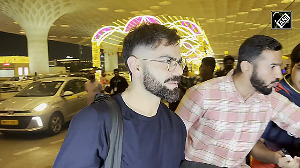 Sanjay Kapoor is the man handpicked by Sunil Mittal, the founder promoter of Bharti Enterprises, to get the next 100 million subscribers for the group's mobile telephony arm, Bharti Airtel. In the space of just a year, Kapoor has been promoted a second time.
Sanjay Kapoor is the man handpicked by Sunil Mittal, the founder promoter of Bharti Enterprises, to get the next 100 million subscribers for the group's mobile telephony arm, Bharti Airtel. In the space of just a year, Kapoor has been promoted a second time.
On Wednesday, he was made Airtel's chief executive looking after India and South Asia, replacing Manoj Kohli, who has been moved to international operations.
Kapoor, who joined Bharti in 1998 after 14 years with Xerox, moves into the corner office at a time when the country's largest mobile phone operator faces its toughest challenges yet.
The half-a-dozen new entrants in the market, of which some like Etilasat and Telenor have swollen purses, have triggered a no-holds-barred war that has brought tariffs down to one paisa a second.
Some older ones like Tata Teleservices have stoked this fire with innovative schemes of their own. That has created a situation in which Airtel, despite being the incumbent and market leader, has been forced to respond in kind, with tariff salvos of its own, even though it is generally new entrants that try to lure consumers with low tariffs.
This is also a time when Airtel is consolidating in South India, Sri Lanka and Bangladesh, the last being a fresh entry for it through the acquisition of 70 per cent equity early this week in Warid Telecom, the fourth largest player in that country out of six.
But Kapoor is no stranger to odds, or competition. An MBA from the UK's Cranfield School of Management, he made his bones at the turn of the century when Airtel stepped out of its comfort zone in North India and invaded the bastions of BPL and Hutch-Essar (now Vodafone-Essar) in the west of the country, especially the dog-eat-dog market of Mumbai.
He was in the thick of things again when, as president of the mobile business, he spearheaded Airtel's expansion to all corners of the country four years ago. He rolled out the services tower by tower, circle after circle, down to the little hamlets and mofussil villages.
Setting up the mobile business in Mumbai on an 1800MHz band where the big players were already entrenched was a major challenge as there were glitches in connectivity because of the spectrum band.
Kapoor, however, was unable to make much headway as the head of the business process outsourcing company that Mittal started with TeleTech of the US. The joint venture never really took off.
Right now, though, far away from the world of outsourcing, Kapoor has to defend Airtel's 32 per cent share of the market and get to Mittal's avowed goal of the next 100 million customers, which may be 100 times more difficult than getting the first 100 million, now that competition has multiplied and the urban markets are close to saturation.
While at it, he has to keep an eye on the average revenue per user, or ARPU, which has been falling for most mobile operators as they delve deeper into the semi-urban and rural markets inhabited by low spenders.
Kapoor has a strategy. His next subscriber base, he has said, will come from the youth and those living in rural areas.
"Right now, around half the new customers are rural; in the next 100, this could shift to three-fourths -- just 13 per cent of rural India has phones, so there's a long way to go. What will change for us is the brand-connect, the product offerings, the communication and the distribution," he said in an earlier interview.
The new man at the helm has also formulated a policy to increase revenues. In future, he says, revenues have to come from channels beyond plain vanilla voice. Bharti, he says, sells more music than music companies HMV and Saregama put together.
Once the data pipe gets broadened with 3G and HSPA, more internet applications would come up.
His biggest hope, though, is pinned on m-commerce. His strategy is simple: First tap 80 to 85 per cent of the population which is still unbanked and looking to do financial transactions.
So the mobile could become the ATM machine, or the money transfer device, for which at the moment rural India uses the post office. Post offices handle more than Rs 50,000 crore (Rs 500 billion) of cash a year. The mobile phone could make do with some of it.
Image: Sanjay Kapoor






